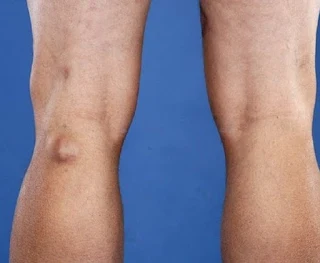A Baker’s cyst also known as a popliteal cyst is a medical condition wherein excess fluid (synovial fluid) accumulates and forms a bump behind the knee. The condition is usually the result of a knee joint disorder such as cartilage tear or arthritis. The cyst is named after a British surgeon William Morrant Baker, who first defined the disease.
A Baker’s cyst may cause great discomfort and irritation, but the diagnosis of the basic problem and the subsequent treatment relaxes the condition.
Symptoms: In some cases, a Baker’s cyst may produce no symptoms. However, the common symptoms defined in medical terms are as follows:
- Pain in the knee
- Cramping behind the knee
- Bulge or swelling behind the knee
- Bruise on the knee and calf (caused by the rupture of the cyst)
- Swollen leg
- Stiffness
Causes: The synovial fluid is responsible for the proper lubrication of tendons and cartilage. The fluid assists in the smooth movement of the leg and decreases the irritation in the mobile parts of the knee. However, occasionally, the knee produces excess synovial fluid, which results in the overload of fluids in the sacs and pockets of the knee, this condition is called a Baker’s cyst.
The causes of Bakers cyst can be any one of the following:
- Cartilage tear (knee injury)
- Swelling in the knee joint (caused by different types of arthritis)
- Knee problems other than arthritis
Diagnosis: The diagnosis of a Baker’s cyst includes a thorough physical examination by the doctor. The examination includes the proper analysis of the mass behind the knee. The size of the cyst may hinder the movement of the leg by the patient, and in some cases, a meniscal tear may be detected.
The tests and laboratory examinations carried out for the exact diagnosis of the cyst are the following:
- X-rays to detect problems related to arthritis
- Transillumination (light shining through the cyst) to catch fluid build up
- Magnetic resonance imaging (MRI) for detecting meniscal injury and cyst analysis
- If the pain is severe and the cyst growth is abnormal, some other tests may be prescribed to rule out certain other type of tumors.
Treatment: In accordance with the results of the test reports and study of the symptoms, the following treatments may be advised.
Drainage of Fluid: The doctor may use the needle to drain the fluid from the knee. The process is known as needle aspiration and is done with ultrasound help.
Physical Therapy: Compression wraps, ice packs, and the usage of crutches may decrease inflammation and pain in the knee. Some muscle strengthening exercises may be recommended to reduce the pain and stiffness.
Medication: The doctor may prescribe cortisone injections into the knee to decrease swelling and reduce the pain. However, this may not prevent the cyst to reappear again.
Surgery: If the excess synovial fluid is found to be the cause of cartilage tear, surgery may be recommended to remove or mend the cartilage.
It is important to note that in most cases no treatment is prescribed. The cyst may vanish on its own.
Home Care and Lifestyle Changes: If the cause of the Baker’s cyst is arthritis, the doctor may recommend some self-care steps to alleviate the pain and to reduce the formation of synovial fluid. These are as follows.
P.R.I.C.E: Protection of the legs by walking on crutches, which can reduce the load off the knee. Rest the leg. Ice the sore area. Compression wraps, braces, or sleeves. Elevation of the knee when resting and while sleeping.
Change or reduction in physical routine: The doctor may prescribe scaling down the daily activity in order to rest the knee and alternate forms of exercise suitable for the condition may be recommended.
Non-steroidal anti-inflammatory drugs (NSAIDs): Anti-inflammatory drugs such as ibuprofen, naproxen and aspirin, and acetaminophen may prove helpful in the reduction of pain. Prescribed NSAIDs provide better results than over the counter ones.
Exercises: Some knee exercises may improve mobility and provide relief from the pain. These are as follows.
Back of Knee Stretch: Rest the balls of one foot on a step while standing up. Bend down and try to touch the knees, keeping knees and the back straight. Stay in the position for 15 to 20 seconds and perform the same routine with the other foot.
Straight Leg Raise: Wear 1 pound ankle weights and sit on a chair. Put one foot firm and flat on the ground and extend the other straight in front on the chair. Move the foot a few inches off the chair. Keep the leg straight and hold for 10 to 15 seconds. Rest the leg for few seconds and repeat the steps 3 to 4 times. Repeat the same with other leg.
Bent Leg Raises: Wear 1 pound weights on the ankle and sit on the chair. Extend a leg in the front and stay in the position for 45 to 60 seconds. Bend the knees at an angle of 45 degrees and hold for half a minute. Rest the leg for some time, and repeat 4 to 5 times. Increase the weights according to the comfort and the intensity of the exercise.
Source: https://www.nlm.nih.gov/





